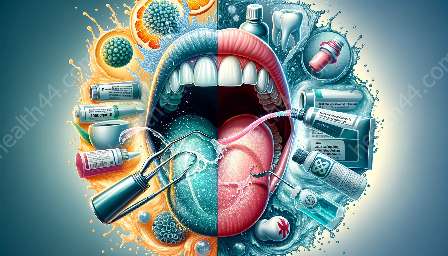Oral thrush, an infection caused by the overgrowth of the Candida fungus in the mouth, can be effectively combated using mouthwash. This topic cluster explores the benefits of using mouthwash in addressing oral thrush, and provides a comprehensive guide on how to use mouthwash for oral hygiene. Additionally, it delves into the role of mouthwash and rinses in maintaining oral health.
Understanding Oral Thrush
Oral thrush, also known as oral candidiasis, is a fungal infection that occurs in the mouth and throat. It is characterized by the development of creamy white lesions on the tongue, inner cheeks, roof of the mouth, gums, and tonsils. The condition is common in infants, the elderly, and individuals with weakened immune systems, as well as those who use corticosteroids or antibiotics.
Causes and Symptoms
The overgrowth of the Candida fungus, particularly the Candida albicans strain, is the primary cause of oral thrush. The fungus naturally resides in the mouth in small quantities, but factors such as a weakened immune system, uncontrolled diabetes, poor oral hygiene, smoking, and dry mouth can lead to its proliferation. Common symptoms of oral thrush include creamy white lesions, a cottony feeling in the mouth, loss of taste, and difficulty swallowing.
Role of Mouthwash in Combating Oral Thrush
Mouthwash offers an effective means of combating oral thrush by directly targeting and eliminating the Candida fungus from the oral cavity. Antifungal mouthwashes are specifically formulated to contain agents that disrupt the cell membranes of the fungus, thereby inhibiting its growth and promoting its elimination.
Antifungal Agents in Mouthwash
Antifungal mouthwashes often contain active ingredients such as chlorhexidine, nystatin, and fluconazole. Chlorhexidine is a broad-spectrum antimicrobial agent that effectively combats fungal and bacterial infections in the mouth. Nystatin, a polyene antifungal medication, targets the cell membrane of the Candida fungus, disrupting its integrity. Fluconazole, an azole antifungal agent, inhibits the synthesis of ergosterol, a key component of fungal cell membranes, leading to the destabilization and eventual death of the fungus.
Effectiveness of Mouthwash
Studies have demonstrated the efficacy of antifungal mouthwashes in combating oral thrush, with significant reductions in fungal load and symptomatic relief observed after regular use. In addition to targeting the underlying fungal infection, mouthwash also helps in maintaining oral hygiene by reducing plaque, gingivitis, and bad breath.
How to Use Mouthwash for Oral Thrush
Proper use of mouthwash is essential for maximizing its effectiveness in combating oral thrush.
Step 1: Choose the Right Mouthwash
Select an antifungal mouthwash recommended by your dentist or healthcare provider. Look for active ingredients such as chlorhexidine, nystatin, or fluconazole.
Step 2: Read the Instructions
Carefully read and follow the instructions provided on the mouthwash label. Pay attention to the recommended dosage and frequency of use.
Step 3: Prepare for Use
Rinse your mouth with water before using the mouthwash to ensure optimal contact with the oral surfaces.
Step 4: Use the Mouthwash
Pour the recommended amount of mouthwash into a measuring cup or use the bottle cap as a guide. Swish the mouthwash around your mouth for the specified duration, typically 30 to 60 seconds, ensuring that it reaches all areas of the oral cavity. Avoid swallowing the mouthwash.
Step 5: Spit Out the Mouthwash
After swishing, spit out the mouthwash into the sink. Refrain from rinsing your mouth with water immediately after spitting out the mouthwash in order to allow the antifungal agents to have a prolonged effect.
Mouthwash and Rinses for Ongoing Oral Health
Beyond combating oral thrush, mouthwash and rinses play a crucial role in maintaining ongoing oral health. Regular use of mouthwash offers several benefits, including:
- Reducing plaque and gingivitis
- Neutralizing bad breath
- Preventing cavities and tooth decay
- Soothing canker sores and minor oral irritations
Types of Mouthwash
Mouthwashes are available in various types, including fluoride mouthwashes, antiseptic mouthwashes, and natural mouthwashes. Each type offers distinct benefits and can be chosen based on individual oral health needs.
Proper Use of Mouthwash and Rinses
To derive maximum benefit from mouthwash and rinses, consider the following tips:
- Use the recommended amount of mouthwash as specified on the product label.
- Avoid eating or drinking for at least 30 minutes after using a fluoride mouthwash to allow the fluoride to take effect.
- Consult your dentist or healthcare provider to determine the most suitable type of mouthwash for your oral health needs.
- Incorporate mouthwash into your daily oral hygiene routine, alongside brushing and flossing, for comprehensive oral care.
Conclusion
Mouthwash serves as a valuable ally in combatting oral thrush, offering targeted antifungal action and contributing to overall oral health. By understanding the causes and symptoms of oral thrush, as well as the role of mouthwash in addressing the condition, individuals can effectively incorporate mouthwash into their oral hygiene routine. Furthermore, the ongoing use of mouthwash and rinses provides a holistic approach to oral health maintenance, yielding benefits beyond the treatment of oral thrush. By adopting proper techniques for using mouthwash and selecting the appropriate products, individuals can enhance their oral care regimen and promote a healthy oral environment.









